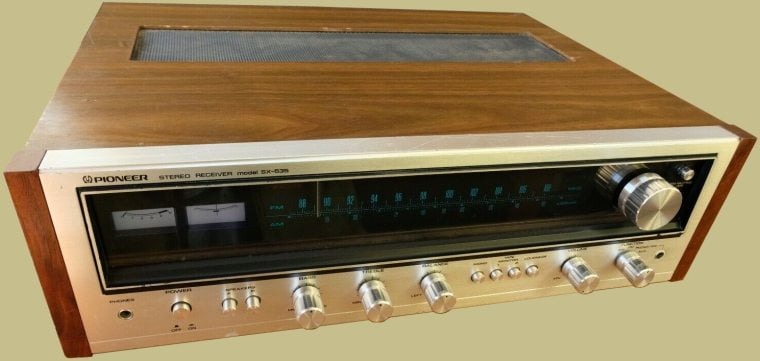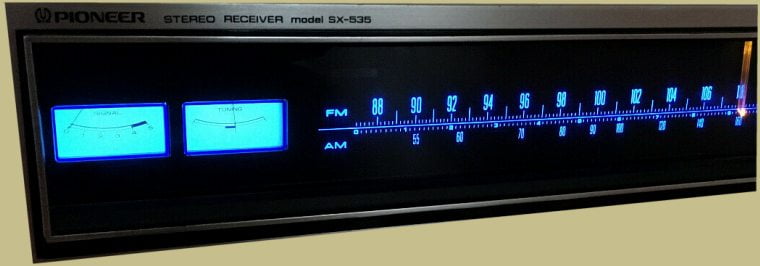
This Pioneer SX-535 was a modest offering from Pioneer in the mid 1970’s and retailed for $299.95. On the market from 1974 until about 1976 the SX-535 produced 20 watts per channel into 8 ohms. Other Pioneer receivers released in 1974 included the SX-636 and SX-737. The wood cabinet, walnut end caps, brushed aluminum silver front and blackout dial face gave it a distinctive mid 70’s look. Pioneer always had the classy beveled knobs as well.
Oh, and that blue glow is hypnotizing!

Developed before the wattage war of the late 70’s the SX-535 wasn’t a power monster. In fact, Pioneer marketed it as being efficient and asked, “Why pay for watts that are wasted?” Their marketing brochure stated:
“The Pioneer SX-535 combines practical power with advanced features and high performance to prove that high power is not always the answer when it comes to good high fidelity listening.”

Pioneer backed up their marketing claims with a number of quality features. The FM tuner section is excellent and uses a low noise FET and a 3 gang variable tuning capacitor in the front end. The FM MPX circuit is a Phase Lock Loop (PLL) type with an IC. These features result in clear and stable reception with high sensitivity and selectivity as well as a very good signal to noise ratio. Both the bass and treble tone controls are click-stop design.

Pioneer also included a very good phono section in the SX-535 that uses a 2-stage direct-coupled equalizer and precise RIAA equalization. This means that the sound on the record is amplified by the SX-535 without any coloration. What was cut into the grooves of the record is what you hear.

The power amplifier is a direct-coupled OCL design and keeps total harmonic distortion at a decent 0.8% or less (over the entire audio range of 20 – 20,000Hz). Pioneer used discrete components in the audio sections (1 IC in the tuning section) which makes the SX-535 easily serviceable.

Specifications:
- Tuning range: FM/AM
- Loudness control
- Muting
- Inputs: Aux, Phono, Tape 1, Tape 2, Mic
- Headphone Jack
- Power output: 20 watts per channel into 8Ω (stereo)
- Frequency response: 20Hz to 30kHz
- Total harmonic distortion: 0.8%
- Damping factor: 30
- Input sensitivity: 7mV (mic), 2.5mV (MM), 150mV (DIN), 150mV (line)
- Signal to noise ratio: 65dB (mic), 70dB (MM), 90dB (line)
- Output: 150mV (line), 30mV (DIN)
- Speaker load impedance: 4Ω to 16Ω
- Dimensions: 480 x 147 x 405mm / 18 29/32 x 5 25/32 x 15 15/16 inches
- Weight: 10.3kg / 22lb 11oz
- Accessories: FM T-type antenna
- Year: 1974

The Pioneer SX-535 is a nice, reliable receiver with plenty of power to run some medium sized, efficient speakers in a smaller listening area. It has minimal, but well performing, features and looks great as well. Anyone needing a lower powered receiver that does the basics very well should take a serious look at the SX-535. Actually, most of the smaller Pioneers of that era were great sounding receivers.


Great information for the Pioneer SX 535–with technical descriptions. Thank you.
I bought my 535 at Navy Exchange in Japan in 1973 also 2 speakers it is now showing age, the lights have gone out but still performs very well and pioneer speakers are ready for some work also it was around $350.00. out the door. just need the lights replaced.
Bought mine new in 1975. Had a DuaI turntable and 2 big ass speakers. I was 18. It was a chick magnet. It still works. Gave it to my nephew.
Just picked one of these bad boys up, wondering if someone could help with setting up 8 ohm speakers to it. Says a+b for 8 ohm or more/speaker. Does that mean I hook up right channel to a, left channel to b? Seems like a stupid question but I haven’t been able to find any straight forward answer anywhere. Thanks.
I think that’s just for when you have two pair of speakers hooked up. If you have a pair hooked up to A and a pair hooked up to B at the same time then they have to be 8 ohm or greater speakers. If you’re just using one pair of speakers that are 8 ohm then you should be able to hook them up to A only (A left and A right).
No, you can hook to pairs of speakers to this receiver: the A pair and the B pair. If you only have one pair hook it up to either the A or B
LH (black) and RH (red) connectors on the back of the receiver and select the speaker channel (A or B) accordingly. If you have two pairs of speakers hook one up to A and the the other pair to B. When you select A+B the receiver will drive both sets. Congrats on your purchase: I bought mine in 1974 and still listen to it.
It means that your “A” side is for use with a pair of 8 Ohm Speakers or greater and you “B” side is also for a pair of 8 Ohm Speakers or greater. To learn if you can hool up 6 Ohm speakers to it, do some research on line. Youtube is a good place to start.
Hi folks. I have one of these but the 6 knobs are missing. I need the Bass, Treble, Balance, Volume and function knobs as well as the larger tuner knob. Can anyone offer some help or tips on where I can find these?
Thanks!
eBay would be your best bet. If you search for Pioneer knobs, the ones for the SX-434, SX-535, SX-636, SX-737, SX-838, SX-939, and SX-1010 would work.
Nice article. Thanks!
I got sx535 from a music store second hand around 1979. The front glass was missing/broken and the tuning needle was gone but other than that it was fully functional. I purchased a piece of plexiglass and fitted it and used a piece of plexiglass for the needle. I had a set of Maranz speaker 3 way that had a black foam front covers . From my memory, It sounded great. I used it for the next 10 yrs and loved it. Unfortunately something stopped working and a friend attempted to repair it but was unsuccessful. It had plenty of power. Really nice receiver… That was when “20 watts” was really 20 watts.
I found one of these as a tune up project and learned a lot. If you find one of these and test it only to find the speaker(s) is blasting scratch noises, there is likely a DC Voltage reaching the speaker (no bueno). Some dude made a great video on big tech, gov-censored YT debugging the problem. This is a transistor problem that seems to be frequent for this specific transistor used, and their degradation is pretty common with this line of of pioneers.
THD is .08%
It’s .08 at 1W + 1W power output. It’s .8 at 40Hz – 20kHz power output. I usually use the latter measurement since it’s over a range of frequencies. I guess it doesn’t really matter which you use as long as you’re consistent when comparing receivers.